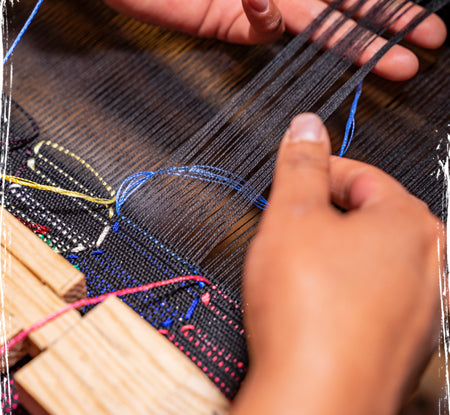By: Miguel González

Nestled among the green mountains stands the town of Zunil in the highlands of Guatemala. The diversity of colors among the houses and the polychromy of nature is reflected in the fabrics that the people of Zunil use to make their clothing. This is a sign of a cultural expression that transcends borders. These typical garments are valued in other countries for the comfort and freshness of the materials used, but in Zunil, this quality is standard.
"My foot loom is worth gold because it has been and is my working tool since I was a child. With this loom and its other components, we have lived and grown culturally, spiritually and materially together with my family," says Francisca Xic Ramos. She is a weaver of cortes, güipiles, belts, straps, and other handcrafted garments typical of the Zunil culture.

Seeing women weaving in the courtyards and corridors of their homes immediately transports the mind to the vestiges of this Guatemalan culture, where Ixchel, a Mayan deity, stands out weaving in ancestral paintings.
Zunil is a town in the highlands of Quetzaltenango, with about 15,000 inhabitants, most of whom are of Mayan descent and speak the K'iche' language. The economy of this town is based on agriculture, weaving, textiles, and trade in various products.

The lives of many of Zunil's inhabitants revolve around weaving. "We as artisans weave our dreams and we can go far," says Francisca.
To weave these multicolored rolls of fabric, the artisans use a medium-sized foot loom, about one meter wide. They complement their textile work with other tools such as the winder, the warping machine, the spinning wheel and the shuttle.

Chocoy, a key component of the loom
The loom is made of wood and has a square shape. Among its main parts are the beamer, the pedals, and the comb, but one of the parts that makes possible the separation, division and interlacing of threads is the abiadura (chocoy, in the K'iche' language.) This component of the loom (made of wooden rulers and threads) is essential for weaving the warp weft and shaping the geometric figures using brocading, also known as a grabbing or "Pepenado" process for shading (darkening or coloring) of an illustration or diagram with parallel lines or a block of color. One of the five loom pedals is used for separating and dividing the yarns using the opening.

The artisans use yarn, silk and mercerize thread for their weavings. The antecedents of the current thread, made from cotton, date back to the pre-classic and classic period of the Mayan culture. This is when the weavers used utensils called cardas, distaff and spindle whorls for spinning; this raw material was cotton and maguey, meaning, natural products.
The weaving process begins with the preparation or purchase of yarn in skeins, which are then reeled into reels for both warp and weft. The warp is prepared in a wooden warping machine; the next step consists of placing the warp on the warping beam of the loom using a rake. Each thread is stealthily passed through the holes of the opening or chocoy, then through the reed/comb and finally the warp is unfolded and ready to weave.

Ancestral fashion designer
"I consider myself an artisan with the ability to make any style of typical garment, especially Zunil cortes. I am an ancestral fashion designer and a designer of current typical clothing since clients request costumes with new designs and I have to adapt; however, our textile roots are still in force," says Francisca.
Weaving cortes is meticulous work, requiring a lot of patience from the weavers to create geometric figures or flowers from yarn to yarn. The elaboration of a corte, six yards long, takes from 15 to 20 days, but if the designs are complex, the weaving time can be extended up to two months. On the other hand, a güipil can be woven in eight days.

"Our cultural values, design creativity, garment quality, honesty and hard work helps us draw buyers from other countries. Thanks to Industrias Xela we have work and we continue to grow," she says.
Francisca explains she is happy to know that her weavings are appreciated and valued in other countries. She, her sisters, and her parents form a work team, a family craft workshop that began with her great-great-grandparents, and now they want to perpetuate the ancestral textile heritage. "Without the help of my parents and grandparents, we would not have this knowledge and our material things," she adds.
The dream of a weaver is to go far and travel to the places where her products are valued; she wants to meet and greet the people who use her weavings.

History of the Zunil loom
The first foot looms that arrived in Zunil were simple and there they wove cortes (yardage of textiles) with little designs or brocade, but over time, other pieces were added that have been adapted to fit the needs of customers such as the design and size of the garments. In Zunil, belts and straps are also woven.
The mixture of the foot loom (which arrived from Europe during the 16th century) with the backstrap loom has resulted in other looms of various sizes that are used in various regions of Guatemala.

The backstrap loom is clearly from the Mayan culture, as shown in the codices and vessels, where women weavers are seen, among whom stand out the Mayan deity Ixchel, in relation to weaving and replication.
Francisca gives a message of encouragement to the young people of Zunil and other villages, urging them to weave to maintain the heritage of their ancestors and preserve the Mayan textile heritage and patrimony. However, she especially encourages them to have options for survival, since weaving is always in demand and can become another source of income for families. "You can start from scratch and go far," Francisca concludes.





